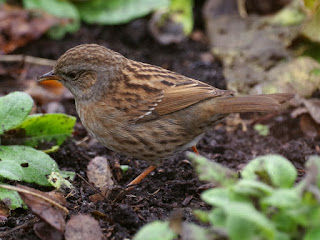It was a foggy day and got foggier by the hour. This made it hard to get pictures of the Little Owls, because they have to be photographed from a distance. Nevertheless, both the female near the Albert Memorial ...
... and the male near the Henry Moore ...
... were both out and staring down serenely from their trees.
There were Mistle Thrushes all over Buck Hill looking for worms in the wet grass.
I nearly trod on one, perfectly camouflaged among dead leaves, but fortunately it had the sense to fly away rattling loudly as I got within a few feet of it.
Both the Nuthatches in the leaf yard came down to take food from the railings.
There is a new bird feeder hanging in a tree on the south side of the Dell. It's probably full of mealworms, because it attracted Long-Tailed Tits as well as the usual birds.
Mealworms are very attractive to all kinds of birds, but not suitable for hand feeding as they smell terrible, and the smell gets into your equipment and clothes.
A Dunnock was poking around in the Rose Garden.
Two Robins here own adjacent rose beds, and they were having a faceoff across the path. Fortunately both had the good sense to retreat before it came to a fight.
A Pied Wagtail was running up the edge of the deserted terrace of the Lido restaurant.
A Cormorant near the bridge made a tremendous leap from the water and just managed to scramble on to a post.
At the east end of the lake, some Shovellers were shovelling at great and unusual speed. Perhaps this is necessary when there isn't much food in the water. To use the convenient business jargon, it maximises throughput.
A pair of Gadwalls were taking things much more easily at the Lido. They are gentle and mild-mannered ducks, and are seen in pairs much more often than the flashier and more promiscuous species.
A pair of Great Crested Grebes which had been fishing side by side were attacked by a Coot for no particular reason.
They avoided it easily and had a little display to congratulate each other.













Coots look like the bullies of the pond, and that is including swans.
ReplyDeleteTheir crazy aggressiveness seems to be a successful strategy. They were only introduced into London in the 1920s, by putting Coot eggs into Moorhen nests. Now they outnumber Moorhens ten to one, and numbers are still increasing rapidly.
DeleteI've seen them turn on their own offspring and peck savagely at the weakest of them. Have you seen behaviour like that also?
ReplyDeleteYes. Sadly it seems to be common. Efficient but horrible.
Delete